How Changed Consumption Habits Can Protect Planetary Boundaries
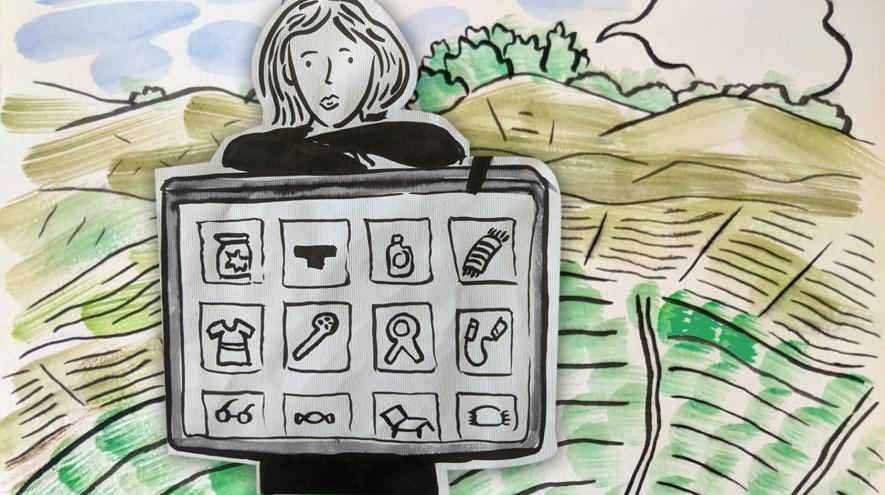
The past couple of months have shown those of us who have the purchasing power to consume a multitude of things that it is possible to do with less. Now that products are back in the “currently available” tab, should we resume old habits? After all it will keep the economy running. In any case the Earth’s climate and biodiversity has never been constant. The nature of evolution is such that those who can adapt, will.
Earth was a hot viscous planet lacking life and oxygen 4.5 to 4 billion years ago. Water evaporated instantly into gas. Earth’s hellish and deathly childhood is rightfully named the Hadean Eon after the Greek God of the underworld, Hades. The fact that Earth could transform from into the benevolent mother Gaia is a demonstration of a magical act.
But transformation has been a slow process based on an ever growing network of feedback loops.
Eventually the Earth cooled and developed a firm crust—the mantle—upon which water molecules precipitated to form oceans and rivers. Cyanobacteria thrived in this limited oxygen environment, gradually releasing more oxygen via photosynthesis. Eventually larger plants emerged, making the planet oxygen-rich, encouraging animals to evolve and consume the excess oxygen.
James Lovelock, a British chemist, proposed the Gaia theory in 1971, which views the Earth as a self-regulatory organism, a biological being composed of a web of interconnected biotic cycles, in which diverse plant and animal species rely on each other through feedback loops, and in the process create a climate and environment that is suitable for their continued evolution.
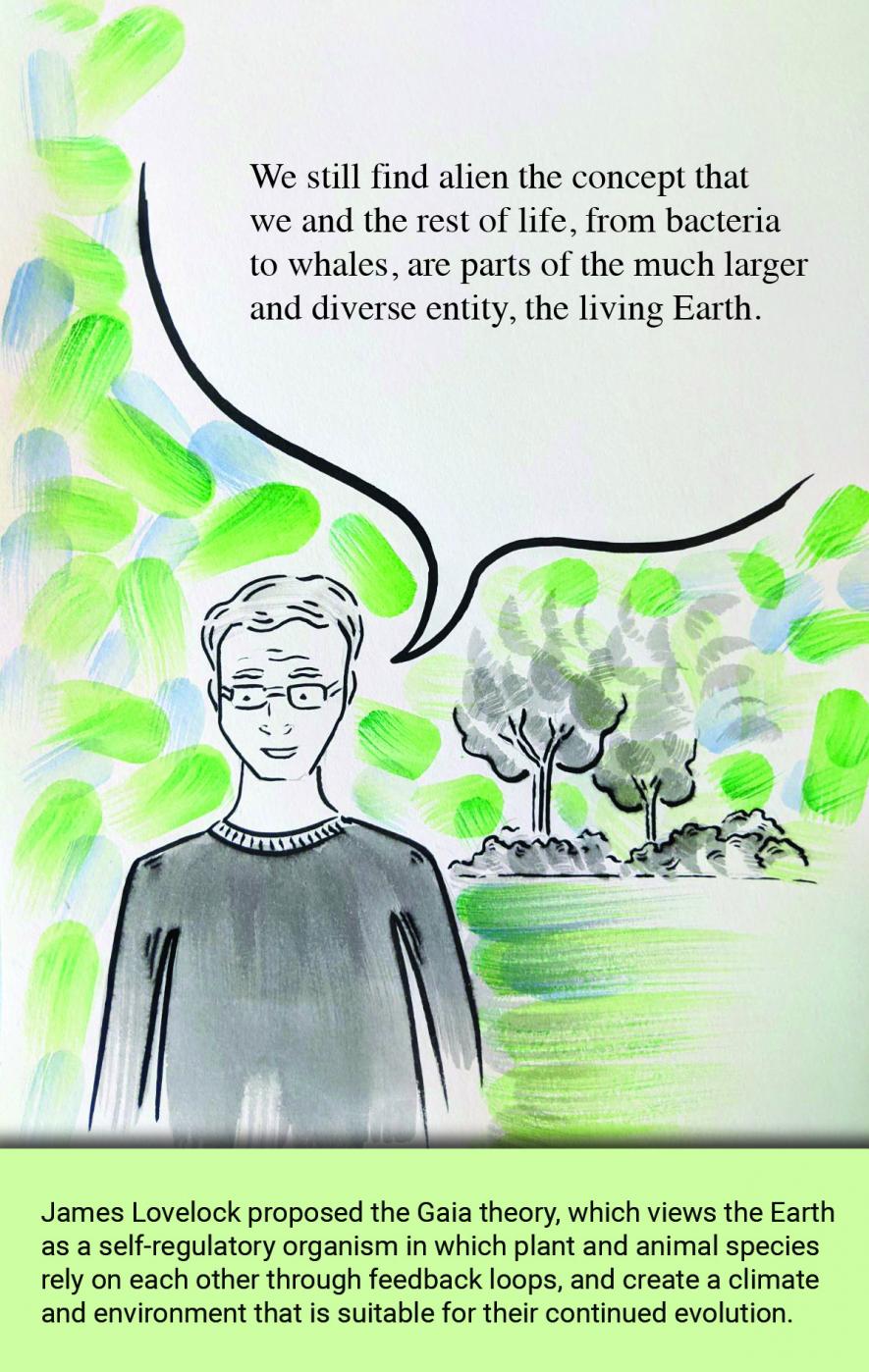
“We still find alien the concept that we and the rest of life, from bacteria to whales, are parts of the much larger and diverse entity, the living Earth.” James Lovelock.
The present era is the Holocene. It began 8,000 years ago when our species evolved into confirmed agriculturalists—which meant a loss of biodiversity as we started selectively breeding and weeding out plant and animal species, and slowly changing land forms by transitioning from villages to complex cities and production bases. But despite these changes the climate of the Holocene remained mostly constant until the Industrial Revolution, when we began to harness energy from coal in huge quantities, and transitioned to an increasingly mechanised model of production. At this point, the speed at which things were produced and consumed could not match the speed at which nature was able to replenish them.
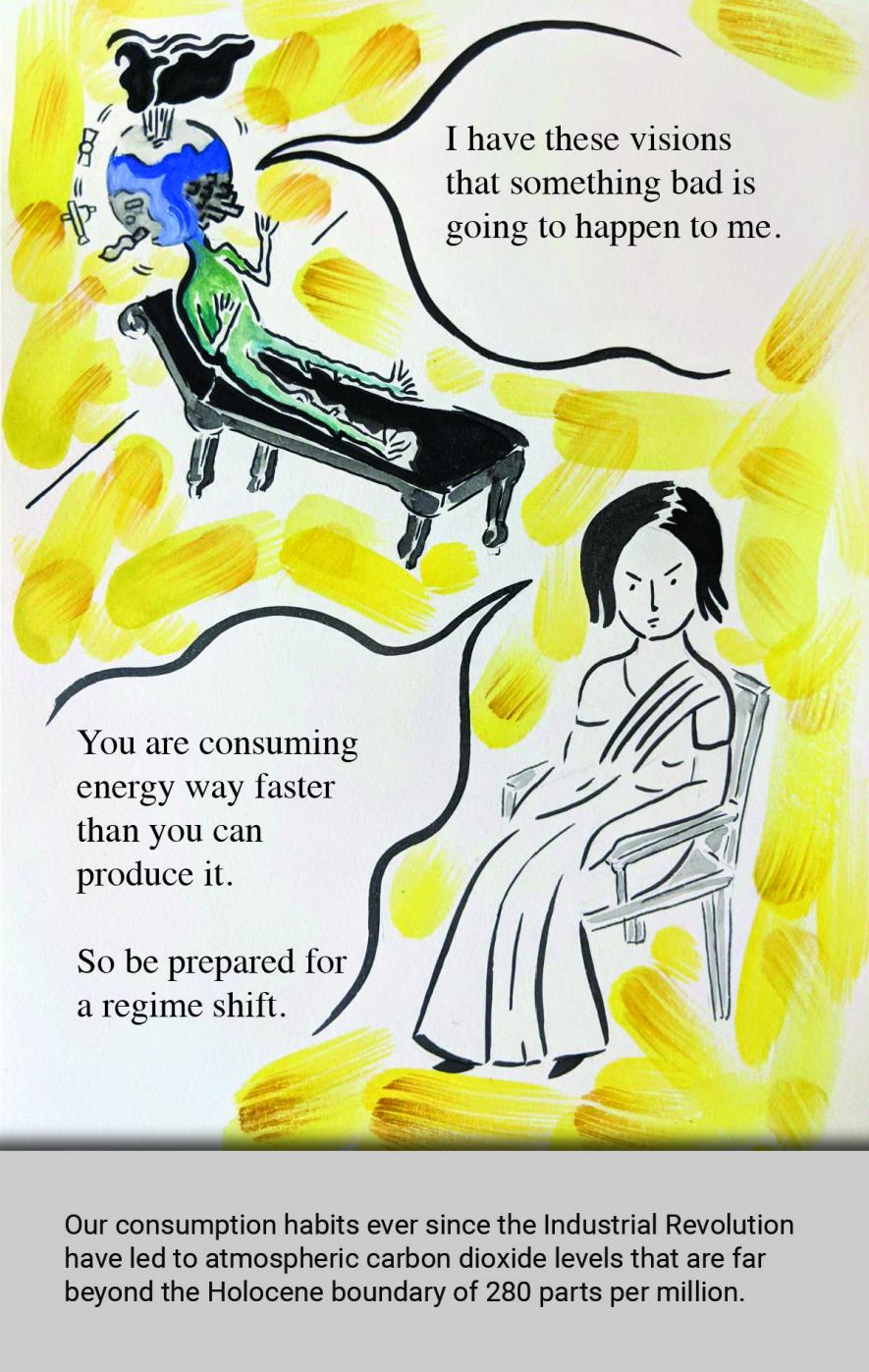
“When we burn fossil fuel for energy we are, in qualitative terms, doing nothing more wrong than burning wood. Our wrongdoing, if that is an appropriate term, is taking energy from Gaia hundreds of times faster than it is naturally made available. We are sinning in a quantitative not a qualitative way.” James Lovelock
This imbalance has led to abrupt shifts in the biological feedback cycles that had kept the climate of the Holocene within a constant range. This abrupt shift is known as a regime shift and generally occurs when either keystone species or top predators have been pushed out of a pre-existing regime, leading to the dominance of a new species and thus, a new regime. This can have sudden and unexpected consequences for the climate and other biotic and abiotic cycles. It also impacts the social, cultural, and economic life of humans who depend on a particular regime.
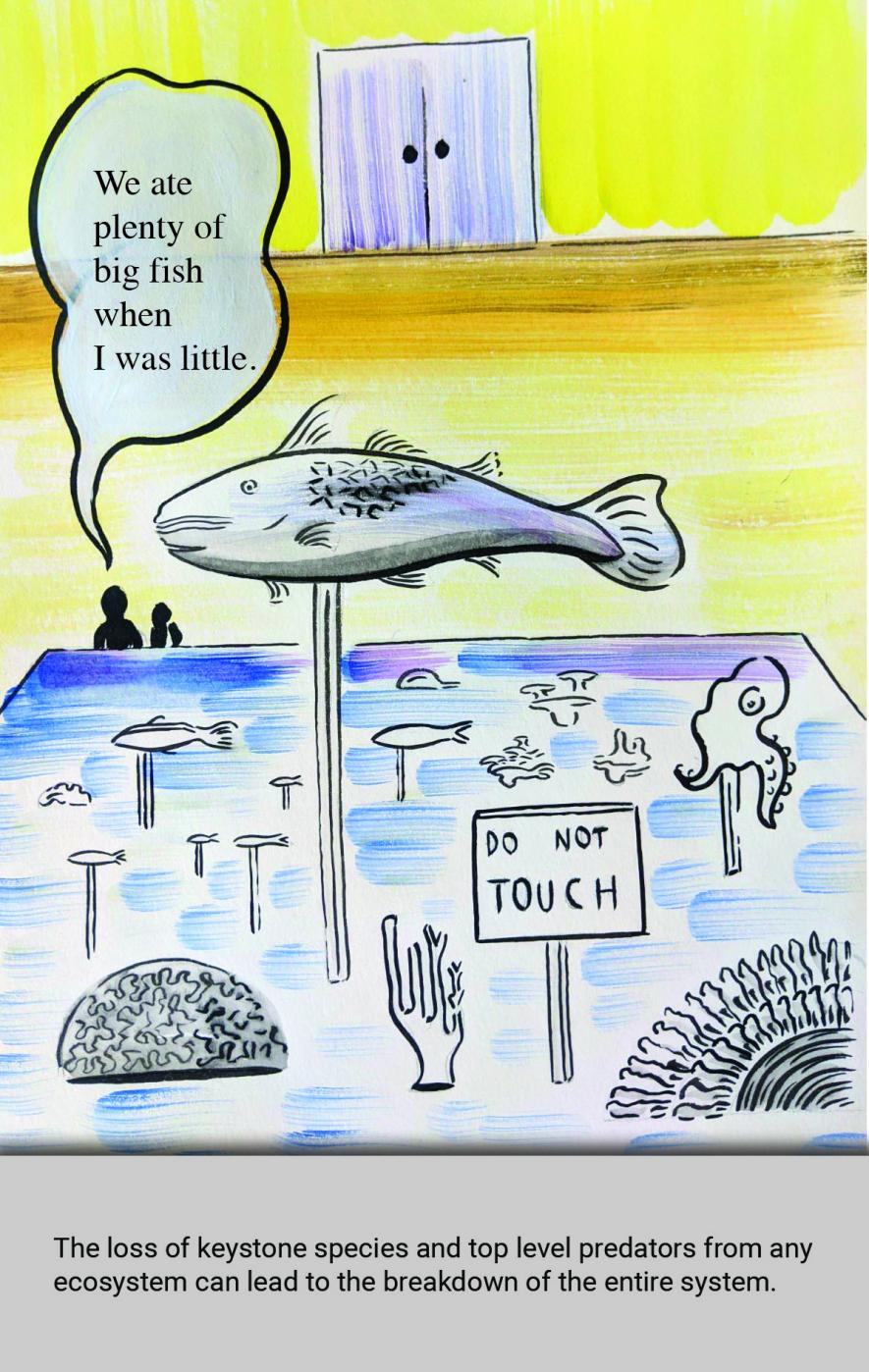
Loss of super predators leads to a regime shift.
For example, overfishing can lead to the loss of valuable game fish. The industrial revolution allowed for large scale fishing of Cod. But by the 1980s, the fish had vanished from the seas of the Baltic. And even a ban on fishing Cod did not help return the fish to the seas.
The presence of Cod kept the quantity of forage fish in the ocean in check. With the overfishing of Cod, forage fish which were now in abundance were in competition with younger cod and would not allow them to survive, soon creating a new regime in which they reigned supreme. Forage fish eat sea plankton. With no-one to keep the numbers of forage fish in check, we might see the vanishing of sea plankton—and let’s not forget that phytoplankton help reduce atmospheric carbon dioxide, or CO2, via photosynthesis. The loss of Cod would have an immediate impact on humans who depend on fishing for their livelihood.
Once a regime has shifted across and a new regime has been set into place, it can be very difficult if not impossible to reverse. The rate at which species are being lost is way faster than the rate at which an ecosystem can respond and adapt. It takes time for an ecosystem to find an alternate solution in the system if a top predator or a keystone species is lost.
Ocean acidification:
Oceans currently remove 25% of human CO2 emissions. Some of it dissolves in the water to form carbonic acid, which reduces the amount of carbonate ions in the ocean—carbonate ions are used by many marine species for shell and skeleton formation, and the loss causes their shells to dissolve. Rising ocean acidification will impact corals, shellfish, and plankton species.
Corals are a keystone species. Coral reefs are like a species rich rain forest of the ocean—home to thousands of variety of marine species, such as sponges, crustaceans, molluscs, fish, sea turtles, sharks, dolphins and many more. Coral reefs also protect our coasts from waves, storms, and floods, helping to prevent loss of life, property damage and erosion.
The loss of a coral reef ecosystem will lead to the extinction of many marine species and a rise of algae-rich seas, as there will no longer be enough predators to eat and control the amount of algae in the ocean. Will that be the food of the future?
Compared to pre-industrial times, surface ocean acidity has already increased by 30%, which is higher than the safe zone for ocean acidification.
Ocean Heating:
The oceans also become much warmer when they absorb excess CO2 from the environment, which leads to melting ice in the poles. Without ice, the ocean warms up even further. We have reached a point at which the loss of summer polar sea-ice is almost irreversible. Rising sea levels and floods will be an inevitable part of our future.
Atmospheric CO2 levels:
Atmospheric CO2 levels are far beyond the Holocene boundary of 280 parts per million. The sea is past its threshold of absorbing excess carbon. Cutting down rich forest land, which also acts as a carbon sink, will make the earth much warmer, even more ice will melt, and sea levels will rise even further. Negative feedback loops of this kind will eventually pull us into a vortex of rising tides.
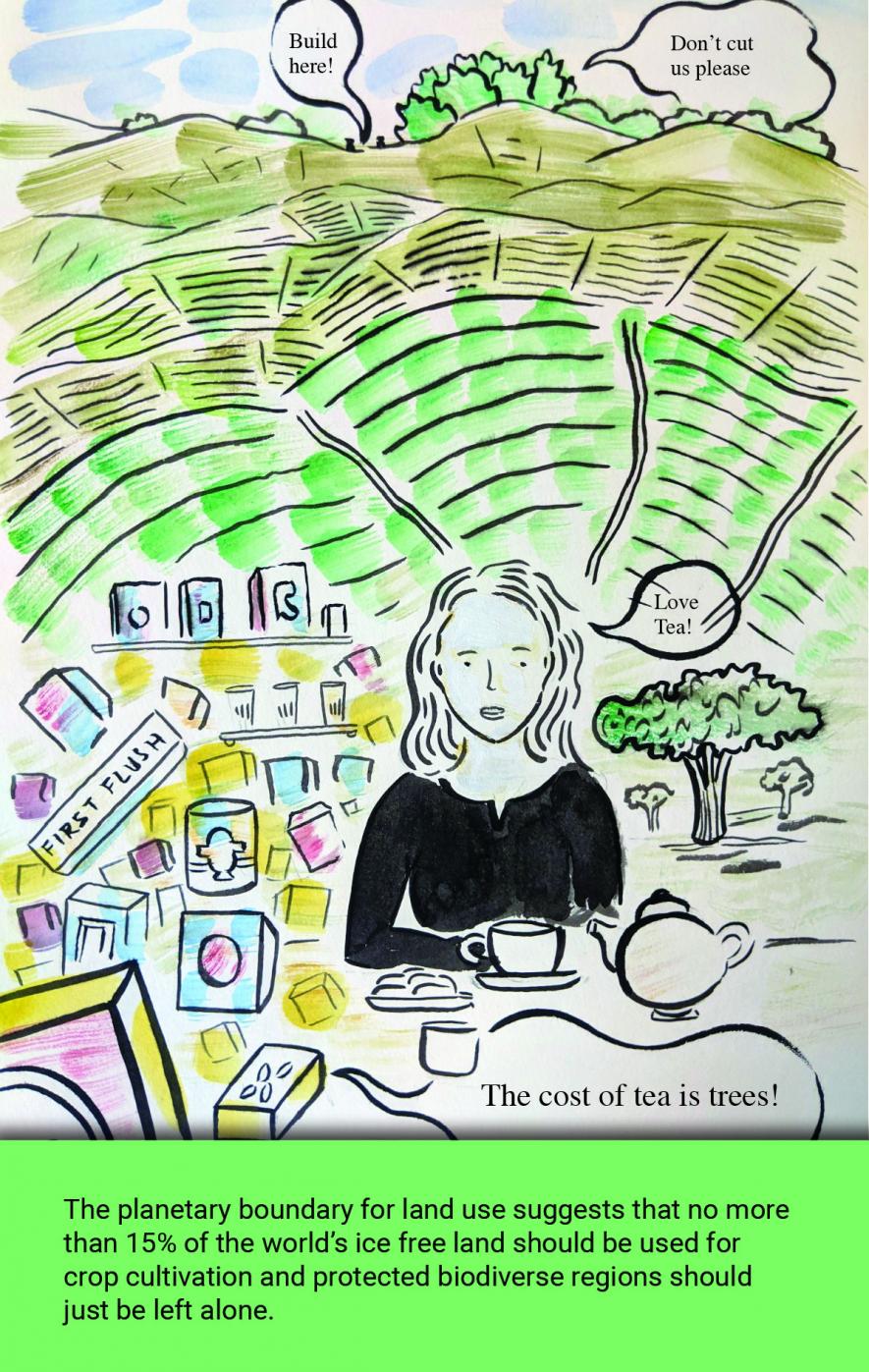
Land Use and Regime Shifts
Land is converted for human use all over the planet. Land use regime shifts are a direct consequence of our consumption patterns, our needs for a variety of goods and services such as food, clothing, transport, housing, production centres, symbols cast in brick and stone, and so much more. Land use regime shifts are both driven by and constrained by economic demand and supply patterns.
For example, for those of us who love our Darjeeling tea, its worth considering the biography of this product. Before 1835 the Darjeeling hill tracts were rich forest lands. The sharp conversion of forest land to tea plantations, and the construction of supporting infrastructure for commercial activities such as roads, buildings, hydroelectric plants, and so on, within the course of a 100 years has led to severe land degradation—25% of the land is now wasteland and cannot be reconverted, and also, made the area more susceptible to landslides. The area saw four landslides between 1950 and 1970, leading to huge amounts of destruction in the socio-economic fabric. The remaining forest land is also not the same as it was before—fragmented forests can never be as biologically diverse as the original contiguous forest.
A planetary boundary for land use:
A group of scientists from the Stockholm Resilience Centre has defined a “safe operating space for humanity” and suggested nine planetary boundaries that should not be crossed. We have already crossed the boundary for safe levels of CO2 in the environment, how close are we to crossing the boundary for changes in land use and what does it imply?
The way we change land usage at a local level, eventually has global repercussions if we aggregate all the instances of change. The conversion of protected and reserve forests, grasslands, wetlands and other vegetation types into agricultural land has had serious impacts on biodiversity, the water cycle, the CO2 cycle and so on. The suggestion is that only 15 percent of the global non ice land should be converted to land for agriculture. We have already used 12 percent. So we only have a 3 percent margin left.
Even if there is a growing requirement for agricultural land, we need to think carefully about how we allocate land for agriculture and urbanisation. No further encroachment should take place in protected and reserve forests, carbon rich soils and other ecosystems. The remaining land needs to be evaluated and highly productive land should be reserved for food crops, not for cash crops or urbanisation. It makes no sense to utilise low-yielding lands for food—a basic need—we will feel compelled to keep stretching our land requirements if our food needs are not met.
We need to continually protect this highly productive land from land degradation and perhaps return to methods to agriculture that mimic natural processes. At a more personal level, those of us who have the purchasing power to keep the wheels of the economy running, we need to start thinking about our choices—manage what we demand from the land—the kind of food we consume, where it has come from, and how much we waste.
Eating local and seasonal food means that we reduce the fuel footprint that foods carry when they come from far-flung places. Rethinking land use in urban spaces. Perhaps local colony parks, traffic islands containing ornamental plants can be converted to vegetable gardens. Avoiding foods and products that are responsible for the decimation of rain forests—palm oil plantations being a major culprit. Even if it is not possible to make changes overnight, it is time we start considering them, so that we don’t reach a point where we have absolutely no choice at all.
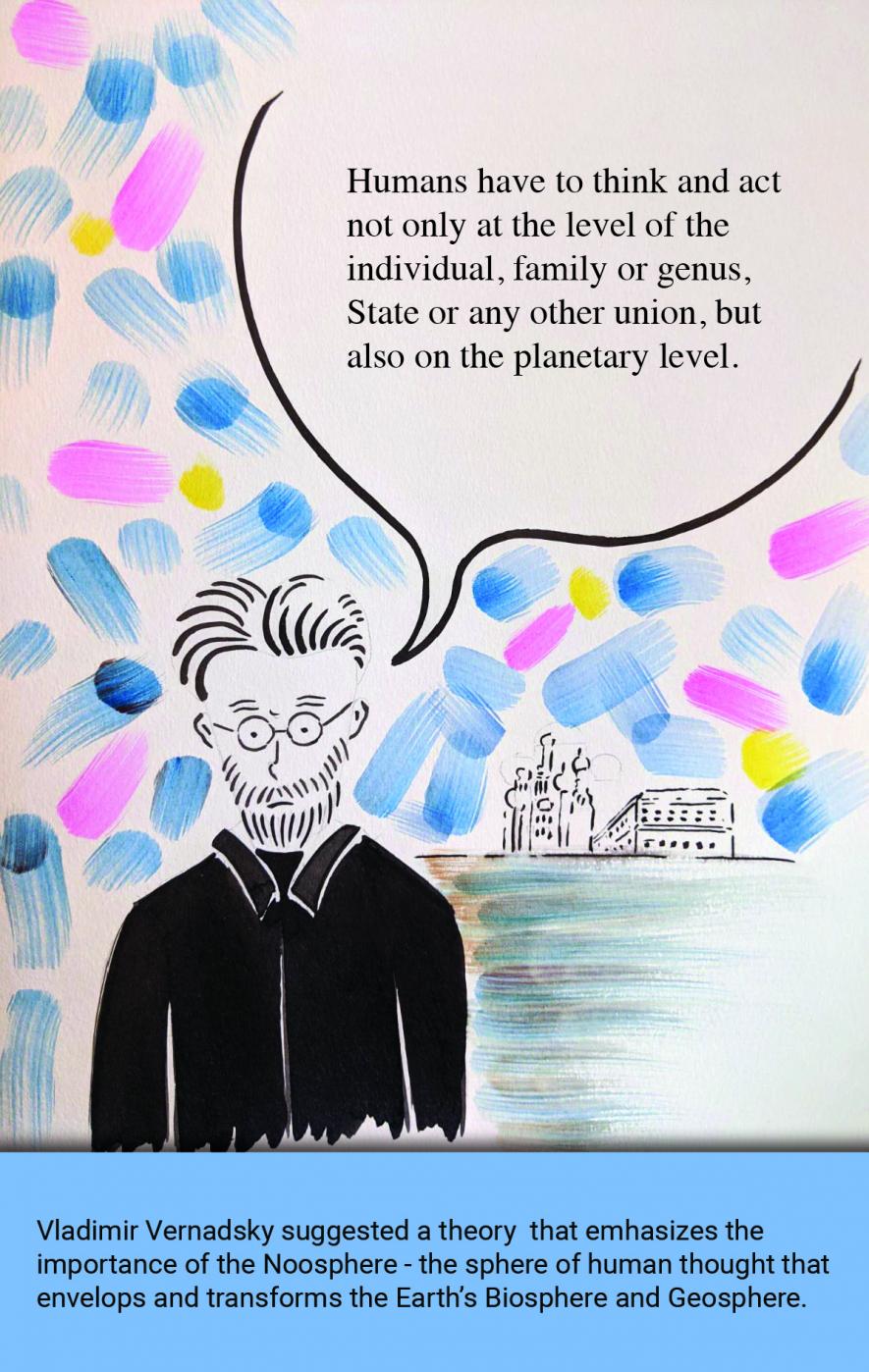
The Noosphere
In the early 20th century, Russian biogeochemist Vladimir Vernadsky suggested an interesting theory that may be worth revisiting. In his view the Earth’s development has undergone three stages.
1. Geosphere (inanimate matter that the earth is made up of from her core to the mantle)
2. Biosphere (biological life that envelops and transforms the earth's mantle)
3. Noosphere (sphere of human thought that envelops and transform the biosphere)
Mastery of language has led our species alone to develop a repository of knowledge that can be quickly learnt, shared and built upon. It has led to the technologically successful world that we rely on today—nuclear energy, cyber networks, advancements in medicine, washing machines, and so on. Today in our networked world—the world mind quite literally surrounds the biosphere, connecting with other minds, and exchanging knowledge and ideas at dazzling speeds. What if all of us think together, and more deeply, about how our thoughts, ideas, and actions can have a transformative impact on the Earth’s Biosphere and Geosphere.
“Humans have to think and act not only at the level of the individual, family or genus, State or any other union, but also on the planetary level.” Vladimir Vernadsky.
Illustrations by Shoili Kanungo.
Get the latest reports & analysis with people's perspective on Protests, movements & deep analytical videos, discussions of the current affairs in your Telegram app. Subscribe to NewsClick's Telegram channel & get Real-Time updates on stories, as they get published on our website.
























